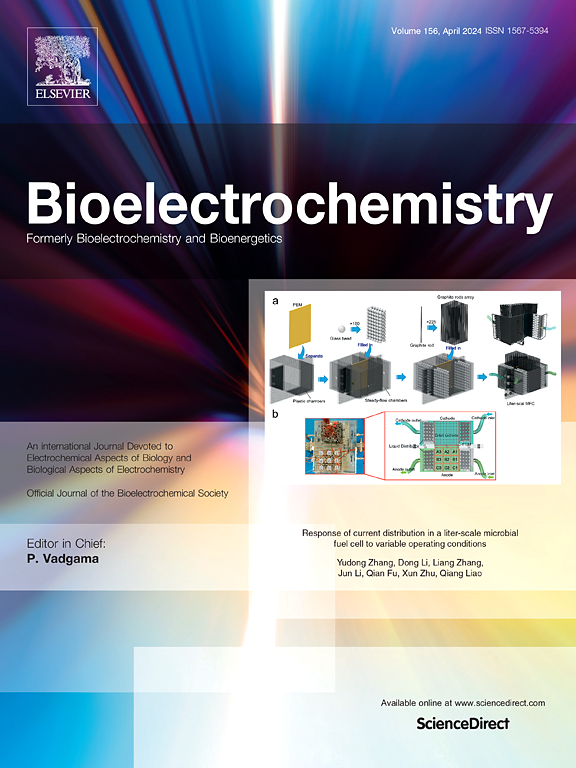基于还原氧化石墨烯、聚吡咯和金纳米颗粒纳米复合材料的用于PEDV检测的CRISPR-Cas13a供电电化学传感器
IF 4.5
2区 化学
Q1 BIOCHEMISTRY & MOLECULAR BIOLOGY
引用次数: 0
摘要
猪流行性腹泻病毒(PEDV)是引起猪流行性腹泻的高传染性病原体,可导致新生仔猪严重腹泻和高死亡率,给养猪业造成巨大的经济损失。因此,迫切需要快速、灵敏、准确的PEDV检测方法。在这项研究中,我们开发了一种快速、超灵敏的电化学crispr生物传感器,用于检测PEDV,具有高灵敏度和特异性。该传感器集成了还原氧化石墨烯-聚吡咯-金纳米颗粒(rgo - py - aunp)纳米复合材料,以提高灵敏度和CRISPR-Cas13a靶向识别。该双信号扩增策略在45分钟内实现了1.01 fg/mL的优异分析检出限和在宽动态范围(0.005-100,000 pg/mL)内的高线性(R2 = 0.9979),无需核酸扩增。通过将cas13a辅助的信号增强与纳米粒子介导的电子转移协同作用,该生物传感器在灵敏度上优于传统方法,同时保持了优异的稳定性和特异性,在临床诊断中显示出很强的PEDV检测潜力。本文章由计算机程序翻译,如有差异,请以英文原文为准。
A CRISPR-Cas13a powered electrochemical sensor based on reduced graphene oxide, polypyrrole and gold nanoparticles nanocomposites for PEDV detection
Porcine epidemic diarrhea virus (PEDV) is a highly infectious pathogen responsible for porcine epidemic diarrhea, which causes severe diarrhea and high mortality rates in neonatal piglets, leading to substantial economic losses in the swine industry. Therefore, there is an urgent need for rapid, sensitive, and accurate detection methods for PEDV. In this study, we develop a rapid, ultrasensitive electrochemical CRISPR-based biosensor for detecting PEDV with high sensitivity and specificity. The sensor integrates reduced graphene oxide-polypyrrole‑gold nanoparticle (rGO-PPy-AuNP) nanocomposites to enhance sensitivity and CRISPR-Cas13a for target-specific recognition. This dual-signal amplification strategy achieves an excellent analytical detection limit of 1.01 fg/mL and high linearity (R2 = 0.9979) across a broad dynamic range (0.005–100,000 pg/mL) within 45 min, eliminating the need for nucleic acid amplification. By synergizing Cas13a-assisted signal enhancement with nanoparticle-mediated electron transfer, the biosensor outperforms conventional methods in sensitivity while maintaining excellent stability, and specificity, demonstrating strong potential for PEDV detection in clinical diagnostics.
求助全文
通过发布文献求助,成功后即可免费获取论文全文。
去求助
来源期刊

Bioelectrochemistry
生物-电化学
CiteScore
9.10
自引率
6.00%
发文量
238
审稿时长
38 days
期刊介绍:
An International Journal Devoted to Electrochemical Aspects of Biology and Biological Aspects of Electrochemistry
Bioelectrochemistry is an international journal devoted to electrochemical principles in biology and biological aspects of electrochemistry. It publishes experimental and theoretical papers dealing with the electrochemical aspects of:
• Electrified interfaces (electric double layers, adsorption, electron transfer, protein electrochemistry, basic principles of biosensors, biosensor interfaces and bio-nanosensor design and construction.
• Electric and magnetic field effects (field-dependent processes, field interactions with molecules, intramolecular field effects, sensory systems for electric and magnetic fields, molecular and cellular mechanisms)
• Bioenergetics and signal transduction (energy conversion, photosynthetic and visual membranes)
• Biomembranes and model membranes (thermodynamics and mechanics, membrane transport, electroporation, fusion and insertion)
• Electrochemical applications in medicine and biotechnology (drug delivery and gene transfer to cells and tissues, iontophoresis, skin electroporation, injury and repair).
• Organization and use of arrays in-vitro and in-vivo, including as part of feedback control.
• Electrochemical interrogation of biofilms as generated by microorganisms and tissue reaction associated with medical implants.
 求助内容:
求助内容: 应助结果提醒方式:
应助结果提醒方式:


